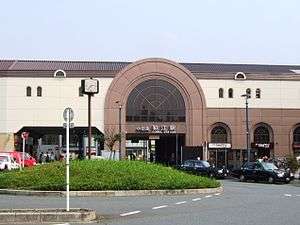Komae Station
Komae Station (狛江駅, Komae-eki) is a railway station in Komae, Tokyo, Japan, operated by the private railway operator Odakyu Electric Railway.
 Komae Station 狛江駅 | ||||||||||||||||||||||||||||||||||||||||||||||||||||||||||||||||||||||
|---|---|---|---|---|---|---|---|---|---|---|---|---|---|---|---|---|---|---|---|---|---|---|---|---|---|---|---|---|---|---|---|---|---|---|---|---|---|---|---|---|---|---|---|---|---|---|---|---|---|---|---|---|---|---|---|---|---|---|---|---|---|---|---|---|---|---|---|---|---|---|
 Komae Station entrance | ||||||||||||||||||||||||||||||||||||||||||||||||||||||||||||||||||||||
| Location | 1-17-1 Higashi-Izumi, Komae-shi, Tokyo (東京都狛江市東和泉一丁目17番1号) Japan | |||||||||||||||||||||||||||||||||||||||||||||||||||||||||||||||||||||
| Operated by | ||||||||||||||||||||||||||||||||||||||||||||||||||||||||||||||||||||||
| Line(s) | ||||||||||||||||||||||||||||||||||||||||||||||||||||||||||||||||||||||
| Platforms | 2 side platforms | |||||||||||||||||||||||||||||||||||||||||||||||||||||||||||||||||||||
| Connections |
| |||||||||||||||||||||||||||||||||||||||||||||||||||||||||||||||||||||
| Other information | ||||||||||||||||||||||||||||||||||||||||||||||||||||||||||||||||||||||
| Station code | OH16 | |||||||||||||||||||||||||||||||||||||||||||||||||||||||||||||||||||||
| History | ||||||||||||||||||||||||||||||||||||||||||||||||||||||||||||||||||||||
| Opened | 1927 | |||||||||||||||||||||||||||||||||||||||||||||||||||||||||||||||||||||
| Traffic | ||||||||||||||||||||||||||||||||||||||||||||||||||||||||||||||||||||||
| Passengers (FY2013) | 44,158 daily | |||||||||||||||||||||||||||||||||||||||||||||||||||||||||||||||||||||
| Services | ||||||||||||||||||||||||||||||||||||||||||||||||||||||||||||||||||||||
| ||||||||||||||||||||||||||||||||||||||||||||||||||||||||||||||||||||||
| ||||||||||||||||||||||||||||||||||||||||||||||||||||||||||||||||||||||
Lines
Komae Station is served by the Odakyu Odawara Line from Shinjuku to Odawara, and is located 13.8 km from the starting point of the line at Shinjuku Station.
Station layout
The station has two elevated opposed side platforms with the station building located underneath. There are two additional tracks in between to all for the passing of express trains. The space under the train tracks on either side of the concourse is occupied by commercial facilities and a bicycle parking area.
Platforms
| 1 | ■ Odakyu Odawara Line | for Odawara, Hakone-Yumoto and Fujisawa |
| 2 | ■ Odakyu Odawara Line | for Shinjuku |
History
Komae Station was opened on May 27, 1927. The station was not included in the initial construction plans for the Odakyu railway line, but local residents successfully campaigned for a station to be built in this neighbourhood.
Throughout the 1990s it was extensively redeveloped as part of the Odakyu Line's track doubling project. Previous to the redevelopment, the platforms were on ground level and linked by an overhead bridge.
Passenger statistics
In fiscal 2013, the station had an average of 44,158 passengers daily.[1]
Surroundings
The station is surrounded by a suburban commercial district, including a small shopping centre built under the train tracks. Komae City Hall lies to the north of the station.
References
- "Archived copy" 小 田 急 電 鉄 平成17年度1日平均乗降人員・通過人員 (PDF) (in Japanese). Japan: Tokyo Metropolitan Government. Archived from the original (PDF) on 14 October 2013. Retrieved 17 May 2016.CS1 maint: archived copy as title (link)
External links
| Wikimedia Commons has media related to Komae Station. |
- Odakyu station information (in Japanese)